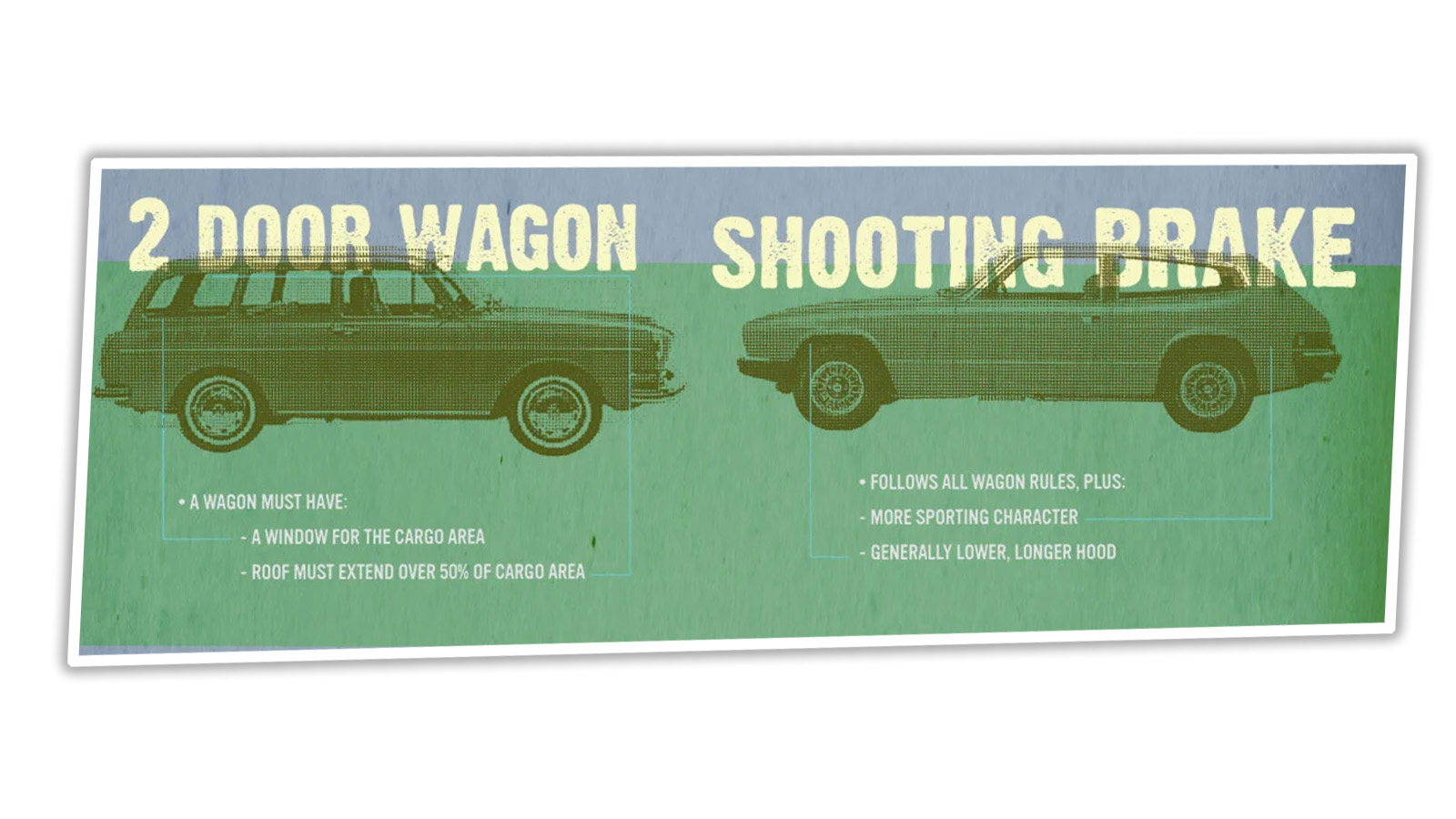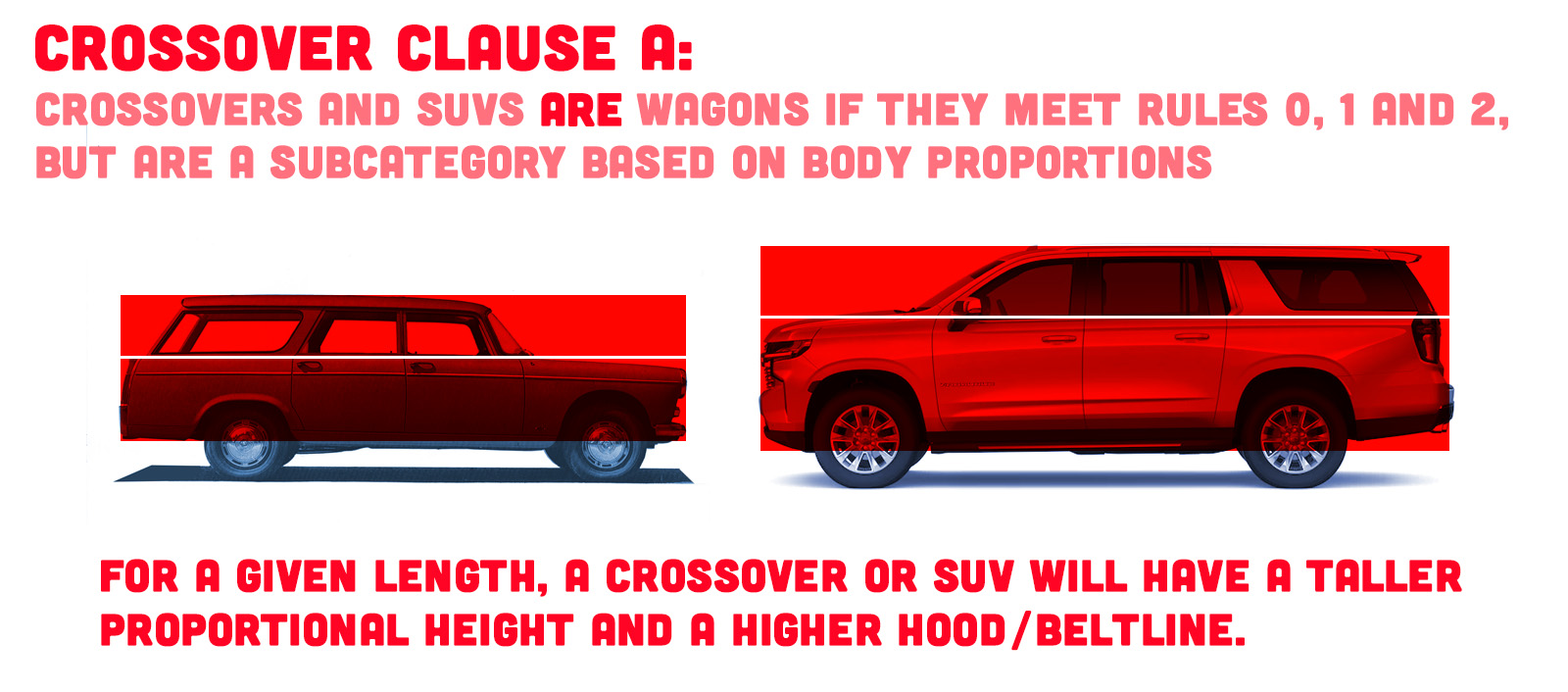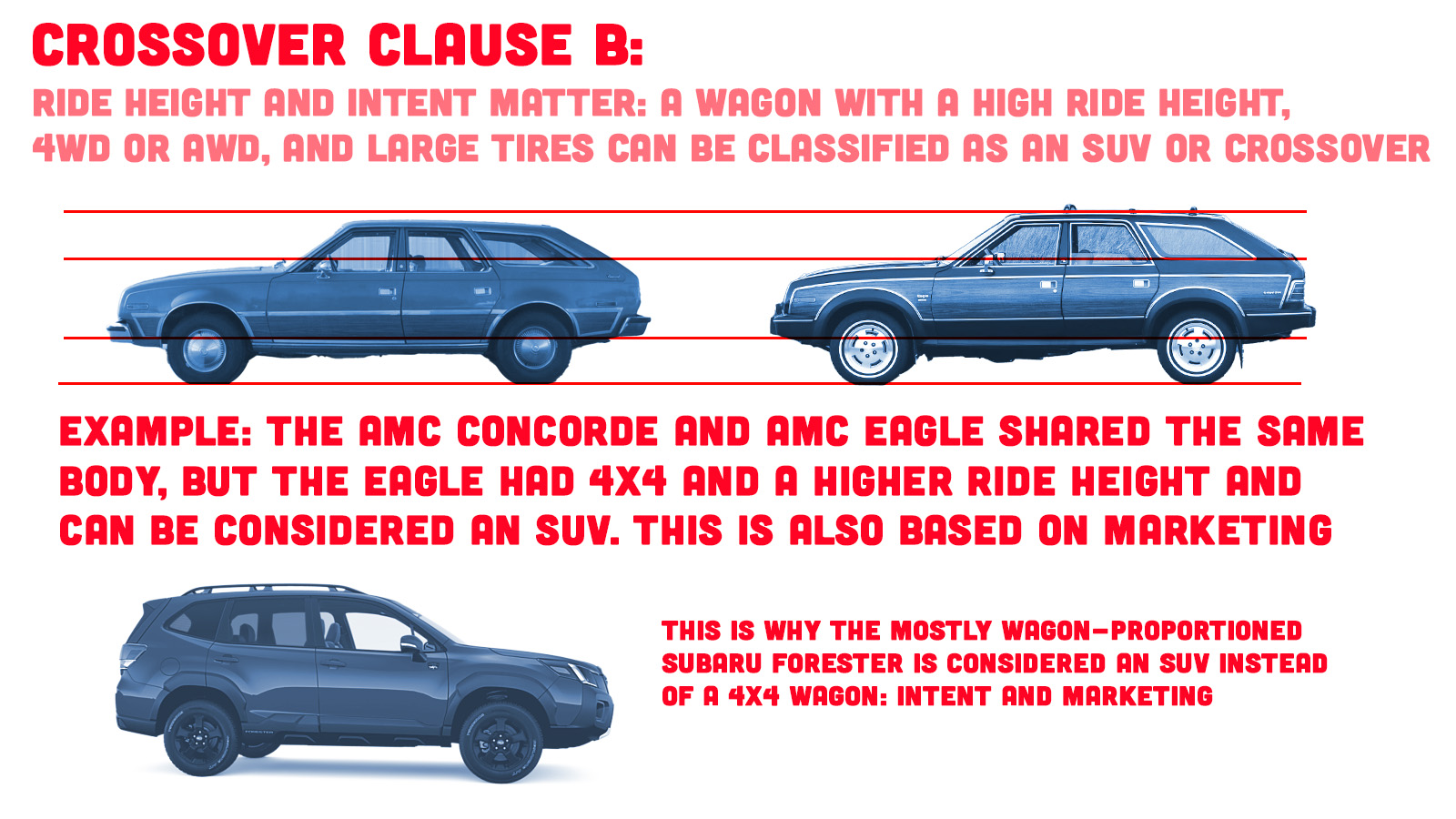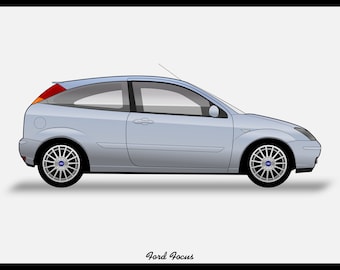Many, many years ago, soon after I started my career as a Professional Automotive Dipshit, I performed a colossal service to humankind: I codified the rules for what defined a station wagon. This was, to my absolute horror, a solid decade ago, and I’m realizing now that these rules need to be restated, and, I think, expanded, just a bit. The basic rules still stand; however, in our era of crossovers and SUVs, I’m realizing that the Wagon Rules need to formally accommodate them, otherwise we’re all in grave danger of tearing ourselves apart. So, let’s get some order back into the universe.
This need was alerted to me via Twitter, when I was tagged in a post discussing a recent Jalopnik article about all the wagons currently for sale in the 2023 model year:
@RSorokanich should go into the @Jalopnik archives and read the Master Thesis @JasonTorchinsky wrote about this.
— Michael Sobczak (@thatsMrSOB) August 31, 2022
The subsequent thread of twitter-fighting about what is or isn’t a wagon was my wake up call that my people need me, and that this madness must be stopped. We all need to agree on just what makes a wagon, which is why I implore you to pay attention.
First, let’s recap the original Two Rules of Wagonhood:


Rule 1 states that the cargo area of a wagon must be provided with side windows. The size or shape of such windows isn’t important, and the glass area of the window can be contiguous with a longer side window that extends from the rear passenger seat, if one is provided.
It should be noted here that the number of doors does not matter: two, four, or even three doors are fine. You can have two door wagons, and, of course, there’s the sporty two-door wagon variant known as the Shooting Brake:

A car that has no window for the cargo area is either a hatchback, or perhaps a van derived from a car, but cannot be a wagon.

The second classic Wagonhood Rule is that the roof of a wagon must cover at least half of the cargo floor:

This means that the roof will necessarily be a bit long, but this doesn’t affect the angle of the rear, or the type of rear door, be it tailgate, side-hinged door, hatch, or whatever. All that matters is that the roof extends over at least half of the floor space in the cargo area, even if that cargo area is small.
A good example of the roof-length rule can be seen in the Volkswagen Dasher/Passat:


Both versions have window area on the sides of the cargo area, but only the Dasher Wagon has a roof that extends to cover over half of the cargo floor.
In the original post, I had a few pass/fail examples:

Okay, I think these rules still stand, and should cover most examples of wagon identification. I did realize that I needed one other rule, though:


Rule 0 is the Two-Box rule. Now, I don’t think this will come up much, but I realized that a number of vans could pass Rules 1 and 2, but they’re clearly not station wagons, because a Wagon Must Be A Two-Box Design. That is, a wagon needs a hood of some kind, even if it has no engine in there or is a bit stumpy or whatever.
Volkswagen tried calling the Microbus a Station Wagon in ads in the 1960s, but we all knew it really wasn’t one: it’s a van. Because a station wagon needs a hood, hence Rule 0.
Okay, now let’s get into what I’m calling the Crossover Clauses. First, know this: Crossovers and SUVs are station wagons if they meet the now Three Rules of Wagonhood. So they can be wagons, but they are a subcategory of wagons, based on the following:

Crossover Clause A reminds us that if the proportions of a given wagon have a higher ratio of height to overall length and a comparatively high hood and beltline, they enter the subcategory of SUV or crossover. I wish I could have hard and fast ratios for this, but the wide variety of vehicle sizes and proportions make this nearly impossible. So, this is a bit subjective on paper, but pretty obvious in practice.

Does the vehicle look tall? Is the hood high? Then it’s likely an SUV/crossover.
We can further refine this subcategorization with Crossover Clause B:

Clause B states that both intent and ride height do matter. If a carmaker gives a vehicle a high ride height, big wheels, 4WD or AWD and a bunch of chunky cladding and a name that suggests something like rocky crags or the animals/people that bound over them, then it’s clear the intent of the vehicle is to be a crossover or SUV.
A great example of this is the AMC siblings Concorde wagon and Eagle. The Concorde wagon was a RWD family wagon, while the Eagle had 4WD and higher ground clearance and bigger wheels, and was marketed as something to take off-road or camping or adventuring or hunting the Most Dangerous Game or whatever.

Both cars had identical sheetmetal, bodies of the exact same dimensions. Yet AMC’s intent was clear: one’s a paved-roads family car, one’s an off-road sport utility vehicle, even if no one was calling them that at the time.
Just look at how they were advertised:

One is sold as “affordable luxury” and one is “built tough, the American Way.” It’s clear there’s very different goals for these two similar, but not the same, cars.
Make sense? Want to try a little test? Let’s do a car that meets the general Crossover Clauses, and see what we get: Hondas HR-V, one from 1999 and one from 2022:


Here’s an example where both could be considered crossovers from a proportion and intent standpoint, but only one, the 1999 one, is an actual wagon. This is very clear: the 2022 HR-V lacks a cargo side window, and the roof is too short to cover more than half of the cargo floor. Essentially, the new HR-V is a crossover-ized hatchback, not a wagon.
Let’s do another Honda example:

The Fit is a wagon. Even if it’s small and has a very hatchback-like rear, it meets the basic criteria, so it’s a wagon.

I hope this helps. Now more than ever it’s important that we find ways to all get along, and the first step to that is getting some real rules in place about what makes a station wagon.
Godspeed.



I remember the day your original wagon rules popped up in my thread a decade ago. It reaffirmed my entire worldview and created numerous disputes amongst my friends and I.
I very much agree with your updates to the rules! However, one thing stuck out to me that may further clarify the rules: rear overhang. While I agree with your classification of the 3rd Gen Civic Hatch and new Honda Fit as wagons, something seemed off. They are definitely cargo and practicality focused, but the proportions are too tall, to a point where I feel they violate the new Crossover Clauses. I believe, in my extremely finite and minor wisdom, that another addition to Rule 0 relating to front vs rear overhang ratio, would clarify much of the debate.
In addition, upon rereading the original set of rules on that once-great automotive news site, I came across a comment which may introduce a further rule or clarification to the current rules. One commenter claimed their 2011 GTI was a wagon per the rules, which upset him. You replied back that due to a lack of window in the cargo area, it was not a wagon. But WAIT: what about the folding-seat cargo areas of many hatchbacks, which can operate primarily as cargo or passenger areas?
I feel that a clarification of what defines a cargo area (dedicated area with all seats fixed in place) may help. Or, a clause that a hatchback that fits the wagon rules may only be a wagon with two doors. On the 2-door GTI, I feel that with seats down, it nears shooting brake territory. That’s how I left my 2-door’s seats all the time. But with four doors, now useless, opening to a folded seat? That, to me, seems wrong, as the doors serve no purpose unless the seats are up, and makes the 4-door GTI model itself NOT a wagon.
The Nissan Cube is an interesting case of “wagon.” If you look at it from the passenger side, it’s a wagon. If you look at it from the driver side, it’s not. However, it *does* have a window in the cargo area, even if it’s only on one side. So I say “wagon.”
That lovely Peugeot 404 is clearly a wagon, by Pininfarina, IIRC. I’d take it in a heartbeat. I almost bought a used 404 sedan back in the 70s, but dithered too long and it got away.
It’s been said before and I’m late to this party, but I definately think there should be a rule defining the length of the rear cargo area, compared to the rest of the car. I even think this is more important than the roof/cargo area ratio. Eg: a Lexus IS Sportcross is more of a wagon than the 3rd gen Civic hatch. Maybe this: the cargo area should atleast be 1 third of the total lenght of the combined cargo/passenger cabin.
With these rules we can definitively call the Ford Flex a wagon once and for all.
Thank you
How do you classify a van based on a station wagon with blanked out windows like the old Peugeot 304 or Opel Kadett vans?
As a further outlier what about the Toyota Crown “van” which is really just a low trim station wagon.
“Or, dumb salesperson was dumb”
Yeah, that’s pretty much what happened. He was really proud to correct me though.
Then he tried to play the car up as super exclusive and hard to get. I walked away.
I always said my Pontiac Vibe is a wagon. Motortrend called it a sport wagon, and these rules reaffirm that it is indeed a wagon.
Ah, I remember the tales of WagonHood! Robbed from the SUVs and gave to the sedans, if I remember correctly.
WagonHood, WagonHood,
Driving through the glen,
WagonHood, WagonHood,
With his band of men,
Feared by the bad, loved by the good,
WagonHood! WagonHood! WagonHood!
It’s Diane ( and not Dayne or whatever ), the French version of Diana ( there’s several Dianas you cna chose the Greek huntress or the British Princess or any other one )
And it was mainly a reshaping of the 2CV to have it fitting better with the time. ( cars with sharp angles )
Dyane, no?
Mere humans will never be able to agree and answer this important question. I propose that someone much smarter than me do the following:
1) Make a website to upload photos of the vehicle desired to be evaluated for it’s wagon-ness. Might I suggest http://www.isitawagon.com it seems to be available.
2) Develop an impartial AI system to evaluate the photo. Be sure to include a bunch of buzz word stuff like machine-learning and cloud based neural networks. Throw in some block-chain for good measure.
3) The decision of the AI is final and whomever should challenge the authority of the great wagon AI shall be banished to purchase used Fiats from Kia dealerships for all eternity.
-OR-
Just make “Is it a Wagon?” a new Autopian feature and we can vote on it based on our collective wisdom. Torch has final say in case of a tie.
That would make a great reoccurring feature. Someone proposes an obscure vehicle, we pick it to pieces in the comments, then Torch drops an official ruling after, say, 48 hours
Does government get to override this rule? The state of Massachusetts says my ’04 Rav4 is a wagon on the registration.
The next question that can be answered: Is it a Crossover or a Hatchback? What is the Kia Soul?
When defining medieval weapons which look similar, one can easily separate them by construction method. (Sword vs grand messer, halberd vs dane axe, mace vs morganstern) I would add a corollary that a car subframe also makes it a wagon.
I personally find that wheel size makes the difference between a wagon and crossover. You can tell at a glance when the wheel is too big for a wagon.
I want to be awkward and throw in some edge cases; first up, what counts as a roof? )
) ?w=600&ssl=1)
?w=600&ssl=1) )
)
Case 1: the Honda Accord Aerodeck
While, in general, it’s a pretty standard shooting brake shape, complete with windows into the cargo area, the tailgate extends substantially into the roof, with the pivot point in line with the rear seat backs, meaning that the actual “roof” doesn’t extend over the cargo area at all; does this then disqualify it from wagon-hood, and, if not, how is this different than a fastback with windowed cargo area, for example a mk1 citroen BX (with the additional window) or a maserati Khamsin? how, exactly, do we define where the roof ends, and the tailgate begins?
Additionally, on a similar basis; case 1b: The Studebaker Lark Wagonaire
This literally has wagon in the name, but it hits a similar issue to the Aerodeck; the roof over the cargo area opens, so is it a roof, or part of the tailgate? I feel this is probably an easier distinction to make though, as the moving section isn’t part of the tailgate itself, so is arguably just a sunroof.
Case 2: the Fiat Panda MK3/4
Pretty much everyone would consider this a hatchback, but it meets all the rules for wagonhood; the roof extends over 50% of the cargo area, it has a (dedicated!) window to the cargo area, and is a two-box design; I’m sure there’s plenty of other hatchbacks that fit the bill here too; I just picked this one as my sister has one, so I’m pretty familiar with it.
Case 3: the Volvo 240 Estate Van (and various others) (https://www.flickr.com/photos/rutgervandermaar/20004338459)
This, I feel, is fairly clean cut, but I wanted to bring it up anyway; does the simple act of blanking out the rear windows de-wagonify even the most wagon wagon to wagon? also, quite a lot of wagons, the volvo 240 included, have additional seating in the boot; when that’s in use, is it still cargo area, or is it seating room, and, if the later, does that de-wagon the wagon into a status of minivanocrity?
However you categorize them they are NEVER a long roof or slicktop long roof. Glad to see mature, seasoned car folks here and not 8th graders begging for attention.
I think the 2 box requirement needs to be more explicit. Something regarding the angle between the hood and windshield and relative length of hood to roof maybe? I don’t see the Fit as a wagon, largely because of this issue. Also, a van with windows and a small hood is still a van.

This is not a wagon:
The rules need to reflect that it isn’t. Fit isn’t either, but it’s not as clear why.
Neither is this:

I must take issue with the Civic Hatchback being classified as a wagon. Per your picture, you are counting the entire rear seat area as part of the cargo floor. If you can use all of the area behind the front two seats as your cargo floor, what 2-door hatchback would not be considered a wagon?
Is this a wagon then?
The Subaru Outback is, and will always be, a wagon. Subaru tried to position it as an SUV, but it started life as a Legacy Wagon with some cladding, then it became what it is now; a lifted Legacy wagon with some cladding.
To paraphrase Peter Venkman: Actually, they’re more like ‘guidelines’ than ‘rules’ — that Honda Fit is NO wagon.
In my mind, station wagons should always be considered to be a car with an elongated cargo area.
For me, a rule should be that if you cover the rear 1/3 cargo area of the vehicle, does the front 2/3 look like a car, or does it look like a truck or van? If the front 2/3 looks like a car, then that is one step closer to being a wagon.
A second rule would be the length of the cargo area. It should be at least a 1:1 ratio to the rear passenger seating area. The length from the back of the rear seat to the back of the front seat would be the gauge. The cargo length needs to be AT LEAST that long. So those Honda Fits wouldn’t qualify as a wagon in my mind.
A third rule would be how you enter the vehicle. Do you sit down into the vehicle, or do you climb up to get into it? If you have to lift yourself up into the vehicle, it’s not a station wagon. If you sit down into the vehicle, like an average sized person would with pretty much any normal car, then you satisfy this rule. This would rule out any obvious SUVs or minivans or crossovers. This kind of goes along with the ride height/intent rule that Jason mentions.
So, Jason, I feel you’ve failed to be a unifying force in this argument and have only served to be more divisive. Maybe we can vote on these rules? Put up a survey, Jason.